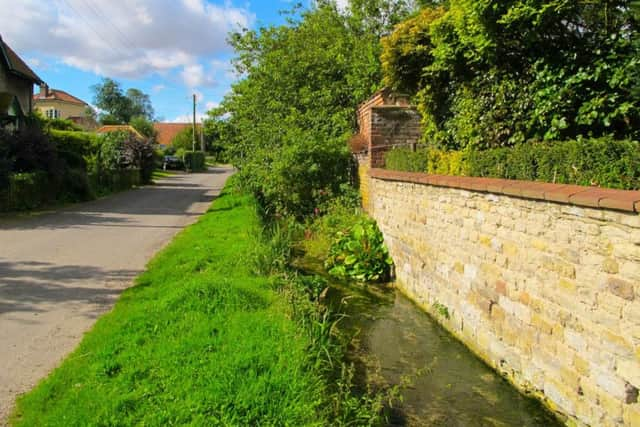Your Day Out: A grand linear walk


The village of Duggleby consists of several farmsteads clustered together, and associated houses with the needs of farmers in mind. This outpost is often referred to as Little Siberia. You can understand why, as you step out to explore the area in winter. Being quite near the Roman road, it’s not surprising that a neighbouring village, ie Wharram, was given ‘le-Street’, to the end of its name.
The Gypsey Race was actually born at Wharram-le-Street. Rising as a spring in the field, it forms a small trickle of a stream. Shortly, the stream runs along the left verge, crosses a landscape of corn and vegetables, and reaches Duggleby. At the T-junction, the Gypsey Race flows directly ahead beside wide grassed verges.
Advertisement
Hide AdAdvertisement
Hide AdIf you head towards Kirby Grindalythe and West Lutton, you’ll see to the horizon a wondrous sight!
Just a field’s width from the roadside features a prominent mound of earth overgrown with trees on the slope of the Wold. This is Duggleby Howe. It’s known to be a Bronze Age burial mound. [It’s perhaps best viewed from the B1253 Sledmere Road.] Excavated over 100 years ago, it revealed ancient stone tools of great quality, a number of bronze implements, and a fine polished flint knife. Not only were treasured artefacts recovered, but several skeletons that indicated the possible resting place of some tribal chief and warriors.
Keeping the same direction of roughly north-east, the Gypsey Race flows towards Kirby Grindalythe, and is viewed to the left of the lane beyond trees lining the route. It’s an elusive stream flowing through a natural trough of the Wolds known as the Great Wold Valley. Sometimes it has a strong flow, but may disappear underground as you’ll observe.
The flows have been considered as supernatural. Since around the 18th century they’ve been associated with foretelling great events – usually calamities. Being harbingers of evil, they’ve acquired the name of ‘Woe Waters of the Wold’ or simply ‘Woe Waters’.
Advertisement
Hide AdAdvertisement
Hide AdHaving meandered through the meadow, it cuts under the road to proceed to Low Mowthorpe. The earthworks of a deserted village are near Low Mowthorpe Farm by the Gypsey Race.
As you meet the B1253, by turning right you have excellent views of the Gypsey Race as it snakes past bushes towards Kirby Grindalythe Church.
Reaching the road junction, by turning right into the village of Kirby Grindalythe along the Sledmere and Driffield road, and then right alongside the Cranedale Field Study Centre, you should take a look at what a fine centre has been created in this small rural community. A range of farm buildings were originally converted and extended to educate students in all aspects of life and science in the countryside. Offering many courses in geography, geology, biology, and farming etc, along with outdoor pursuits too, students come from all over the country, and even abroad!
The crane was once a resident breeding species in England, but would be a rare sight nowadays.
Advertisement
Hide AdAdvertisement
Hide AdContinue just beyond this study centre, and meet the Gypsey Race once more. Follow it upstream to discover on the opposite bank, St Andrew’s Church. The 14th century church spire provides an excellent landmark. The church was beautifully restored in 1878 by GE Street. I suggest you first enter the fine lych gate, ascend flights of steps to the south door, and ponder the task of coffin bearers, and their problems negotiating these steps.
Inside the church is a marvel of creation. On the nave’s west wall is a remarkable mosaic mural which almost covers the entire wall. The Portrayal of Christ’s Ascension was painstakingly created by Italian craftsmen, using hundreds of thousands of tiny coloured tiles. Bearing this image in your mind, return to Duggleby along your outward-going route.
Distance of return route is approximately 4 miles.
lIt is said that ‘Grindalythe’ refers to the Crane family, Gruidae, pronounced “groo-id-ee”. Hence the naming of the Cranedale Centre.